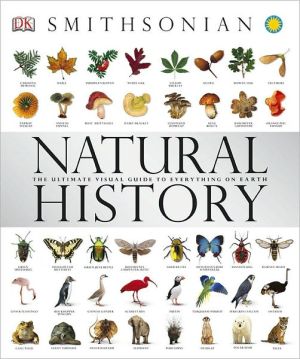Safari Companion: A Guide to Watching African Mammals
Since its original publication in 1993, The Safari Companion has been the best field guide to observing and understanding the behavior of African mammals. An indispensable tool for naturalists traveling to Africa, this new edition has been revised to acknowledge the enthusiasm to those watching these magnificent animals at zoos and wildlife parks, and on film.\ The Safari Companion enables readers to recognize and interpret visible behavioral activities, such as courtship rituals,...
Search in google:
Since its original publication in 1993, The Safari Companion has been the best field guide to observing and understanding the behavior of African mammals. An indispensable tool for naturalists traveling to Africa, this new edition has been revised to acknowledge the enthusiasm to those watching these magnificent animals at zoos and wildlife parks, and on film.The Safari Companion enables readers to recognize and interpret visible behavioral activities, such as courtship rituals, territorial marking, aggression, and care of young. Each account of over 80 species includes a behavioral table in which the unique actions of the hoofed mammals, carnivores, and primates are described for easy reference. In addition, useful maps show the major national boundaries, vegetation zones, and game parks relevant to the guide. The book includes an extensive glossary, as well as tips on wildlife photography, a list of organizations working to protect African wildlife, and advice on where and when to see the animals. Library Journal Anyone who goes on safari will want to make room in his or her suitcase for this treasure. Estes, who is affiliated with Harvard University and the Smithsonian Institute as a research associate, spent over eight years doing fieldwork in Africa and over 17 years leading safaris. His admirable qualifications as an expert on the social ecology of African mammals are reflected in the text, which describes approximately 86 species of African mammals. Introductory chapters give practical advice on how to observe animals, including tips on using binoculars and photographic equipment. Other chapters are arranged by standard taxonomic classification. Estes first covers the characteristics of families and subfamilies and then goes into even more detail on the individual species, charting behaviors one can expect to see and the usual context or meaning. Icons illustrating the behaviors effectively take the reader to a description of the behavior being observed. Appended to the text are a brief suggested reading list, addresses of major wildlife organizations, a glossary of terms, and a thorough index. The only ``fault'' with this exceptionally well-written and researched book is its size. With a 6 9 trim and some 470 pages of text, this is a fairly large, hefty volume to pack on safari--but it is worth the extra effort, as nothing compares with it. Essential for any traveler to Africa, any student of animals or behavior, any zoo visitor, and any size public library.-- Edell Marie Schaefer, Brookfield P.L., Wis.
Chapter 1: Social And Mating Systems\ Although a seemingly endless variety of mammal social and mating systems exists, both between and within species, a small number of basic types form a classification system that makes it easier to see the similarities and differences between species. Most mammals can be placed in one or another of these categories. Table 1.1 outlines the different types of social organization found among African hoofed mammals, carnivores, and primates, and introduces the icons that are used in chapter introductions and species accounts to identify which types apply.\ Certain basic traits of mammals underlie their social and reproductive habits. For example, the presence in females of milk-producing organs helps to explain why most mammals arc polygynous (one male with two or more females). Mammaries enable females to feed offspring without male assistance. Fewer than 10 percent of mammals are monogamous (one male paired with one female). In birds, by contrast, two parents are essential to provision dependent nestlings; over 90 percent of all birds pair up during the breeding season.\ Mammals, descended from a line of reptiles, evolved during the Age of Dinosaurs. In a world dominated by diurnal reptiles, unoccupied niches were available only to small, nocturnal, solitary creatures. The closest living counterparts of early mammals are the insectivores (shrews and their kind). Because good night vision depends nn a high concentration of light-sensitive rods, along with a reflective layer behind the retina, mammals lost the color vision possessed by most reptiles and birds. One consequence is that mammals, except for some monkeys and apes, lack the brilliant coloration seen in reptiles and birds. The superior visual acuity associated with a concentration of color-sensitive cones and frontally placed eyes caused our arboreal ancestors to re-evolve color vision when they became diurnal. Apart from diurnal primates, only a few other mammals arc suspected of possessing some degree of color vision: squirrels, the giraffe, and perhaps lions.\ When the Age of Dinosaurs ended sixty million years ago, mammals responded by producing a multitude of different forms in successive adaptive radiations that culminated in the present (now quickly waning) Age of Mammals.\ By reviewing some of the factors that predispose animals to be solitary or sociable, monogamous or polygrynous, one begins to see the linkage between an animal's size, habitat preferences, climatic factors, activity periods, diet, grouping pattern, and reproductive strategy-in short, to view social organization and mating systems as ecological adaptations.\ TO BE OR NOT TO BE SOCIABLE Like their ancestors, the majority of mammals are still small and nocturnal: mice, rats, and bats account for half the four thousand species. Even within the families of large mammals covered in this book, most carnivores, primates, and solitary antelopes are small compared to a person, a hyena, or a big cat.\ Being vulnerable to the whole array of predatory mammals, birds, and reptiles, small mammals depend on cover, darkness, and secure refuges such as burrows, hollows, trees, or cliffs. Hiding from predators or foraging for dispersed small food items is best done singly.\ Assuming that the solitary state was the original condition of mammals, what are the benefits of group membership that would cause sociability to evolve? Being in a group entrails costs: competition for food and social rank, and greater risks of contracting a disease, for instance. Inevitably, the animals that compete most directly for the same resources are members of the same species, which share the same ecological niche. Within species, competition is potentially most continuous in the same social unit. So, for sociable genes to spread and become the norm for a species, the benefits to the individual of living in a social group must outweigh the costs.\ Three advantages of social groups are generally considered paramount in the evolution of gregarious social systems:\ \ Reduced risks of predation on animals that leave cover and/or become diurnal. In effect, a group substitutes for cover. The more animals in a group, the smaller the predation risk for each individual. Not only are single in dividuals more wary than individuals in a group, but large groups are generally more approachable than small groups. Also, predator surveillance is improved in a group with many eyes and ears. Becoming gregarious was likely a prerequisite to leaving concealment and exploiting open habitats. Even some normally solitary species band together when their refuges are destroyed (see antelope introduction, reedbuck and oribi accounts). Most ungulates that live in open habitats are gregarious, medium-sized to large, diurnal, and adapted to flee rather than hide from predators.\ Increased access to and intake of food. The larger range utilized by a group secures access to more food plants or prey, making it possible to cooperate in locating, catching, and consuming food. There must be enough shared food to go around; small items such as grass, foliage, fruits, fish, rodents, insects, and other invertebrate prey must be in patches dense enough for individuals to forage in a group. For herbivores and insectivores, in particular, the greater security of group membership enables each individual to spend more time eating and less time in surveillance for predators.\ Improved defense of resources against rival groups. If food resources within a home range arc adequate for only one group, competition with other groups is an important limiting factor. Any population in equilibrium with its resources is usually occupying all suitable habitat and producing a surplus of young.\
MapsForewordPreface to the Revised EditionPreface to the First EditionUser's Guide to the Safari Companion1Social and Mating Systems12Observing African Mammals73Understanding Animal Behavor13Pt. IAntelopes and Other Ruminants154Introducing Antelopes and Other African Ruminants165Duikers336Dwarf Antelopes407Gazelle Tribe558Reedbuck/Kob Tribe719Vaal or Gray Rhebok, Pelea capreolus8710Horse Antelopes9211Hartebeest Tribe10412Impala, Aepyceros melampus12713Bushbuck Tribe13314African or Cape Buffalo, Syncerus caffer15815Giraffe, Giraffa camelopardalis164Pt. IIOther Hoofed Mammals17116Swine17217Hippopotamus, Hippopotamus amphibius18518Rhinoceroses19019Zebras and Asses20020Hyraxes or Dassies21421Elephant, Loxodonta africana[superscript en]223Pt. IIICarnivores22322Introducing Carnivores23423Genets and Civets24224Mongooses25125Hyena Family28126Cat Family30027Dog Family32828Weasel/Otter Family353Pt. IVPrimates37129Introducing Primates37230Bushbabies or Galagos37631Monkeys and Baboons38932Great Apes415App. AA Catalogue of Displays and Signals437App. BTips for Viewing and Photographing African Wildlife445Glossary448Suggested Reading455African Wildlife Conservation Organizations457Index458
\ From Barnes & NobleThe best way to get the most out of your safari experience is to be informed about the animals you will be observing, and that's just what this guide will do for you. With lists covering more than 80 species and their habitats, behaviors, and rituals, you'll create and enrich an unforgettable lifetime experience.\ \ \ \ \ Library JournalAnyone who goes on safari will want to make room in his or her suitcase for this treasure. Estes, who is affiliated with Harvard University and the Smithsonian Institute as a research associate, spent over eight years doing fieldwork in Africa and over 17 years leading safaris. His admirable qualifications as an expert on the social ecology of African mammals are reflected in the text, which describes approximately 86 species of African mammals. Introductory chapters give practical advice on how to observe animals, including tips on using binoculars and photographic equipment. Other chapters are arranged by standard taxonomic classification. Estes first covers the characteristics of families and subfamilies and then goes into even more detail on the individual species, charting behaviors one can expect to see and the usual context or meaning. Icons illustrating the behaviors effectively take the reader to a description of the behavior being observed. Appended to the text are a brief suggested reading list, addresses of major wildlife organizations, a glossary of terms, and a thorough index. The only ``fault'' with this exceptionally well-written and researched book is its size. With a 6 9 trim and some 470 pages of text, this is a fairly large, hefty volume to pack on safari--but it is worth the extra effort, as nothing compares with it. Essential for any traveler to Africa, any student of animals or behavior, any zoo visitor, and any size public library.-- Edell Marie Schaefer, Brookfield P.L., Wis.\ \ \ BooknewsAn impressive, very well conceived and executed guidebook. Estes has done deep research into African animal behavior. It is presented here with many lucid drawings (without wasting space on merely pretty pictures). ^Twould be our first choice if stranded on a desert anthill. Annotation c. Book News, Inc., Portland, OR (booknews.com)\ \








